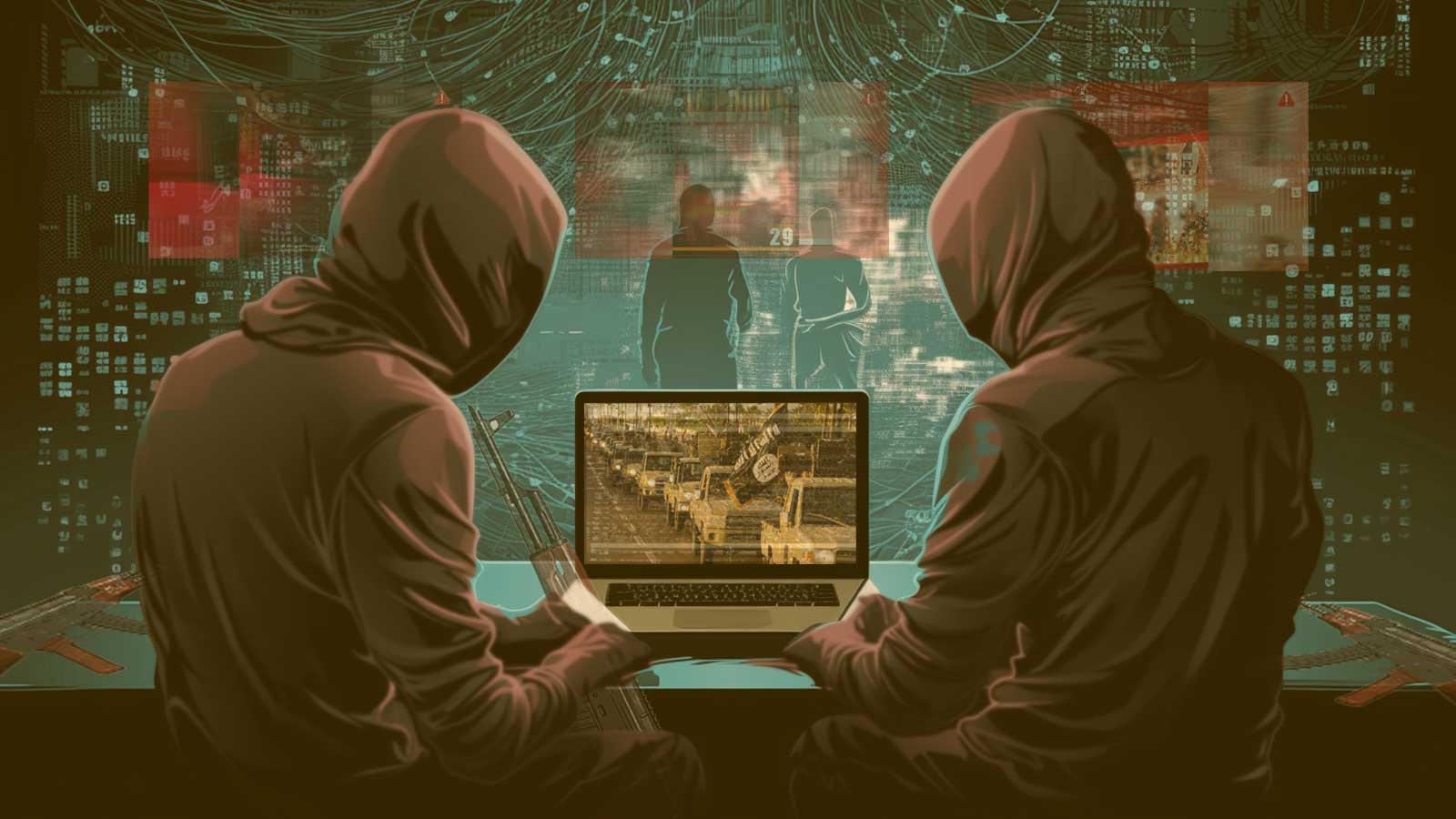
Muhammad Irfan

December 28, 2025
By | Muhammad Irfan , Iftikhar Firdous

As the world grapples with the complexities of maintaining global security, Artificial Intelligence (AI) has emerged as a double-edged sword, igniting a virtual arms race that transcends traditional conflict paradigms.
This new frontier of technological warfare pits peacekeepers against a diverse spectrum of adversaries, from terrorists and extremists to far-right factions, all keenly focused on either dodging AI's watchful eye or wielding it to further their own agendas.
This piece is trying to explore the adaptive tactics and strategies that the actors deploy to thwart and navigate the AI terrain. On the one hand, such groups skilfully manipulate AI to craft and disseminate propaganda, enhancing their recruitment drive and radicalizing individuals on a global scale. On the other hand, they deploy certain tactics to avoid AI detection and thwart it. This piece aims to unravel the sophisticated methodologies adopted by these groups to outmaneuver AI detection systems or to neutralize the surveillance and analytical prowess of governments, intelligence, and counterterrorism bodies, as well as civil society organizations.
This analytical piece unfolds through three critical lenses. First, to explore the realm of Digital Stealth and Evasion Tactics, uncovering the ingenious methods terrorist, extremist or far rightest groups employ to slip through the digital net. This part not only showcases their creative evasion techniques but also underscores the technological hurdles that counterterrorism forces face in staying one step ahead. Second, the focus turns to Technological Exploitation, detailing how these adversaries exploit AI's vulnerabilities to their advantage. From hijacking AI for propaganda dissemination to commandeering these technologies for enhanced operational efficiency, cyber-attacks, and digital combat, this section shines a light on the multifaceted exploitation of AI systems by terrorist, extremist, and far-right groups. Lastly to scrutinize the Physical and Cybersecurity Measures enacted by these factions. By providing a detailed overview of the hurdles in safeguarding global security against the backdrop of technological advancement, this piece offers valuable insights into the ceaseless battle for technological supremacy in the age of globalized threats.
The Digital Hide and Seek: How Terrorist Groups Elude Detection
In the shadowy corners of global security, extremist, terrorist, radical, and far-right groups have developed a sophisticated toolkit to dodge AI detection, leveraging both ancient methods and modern technology to their advantage. The most fundamental of these strategies involves a return to low-tech communication methods, such as couriers and face-to-face meetings. This method, famously utilised by the Taliban's senior leadership in Afghanistan, remains one of the most effective ways to evade digital surveillance by avoiding any digital footprint altogether.
However, as digital communication becomes ubiquitous, these groups have ingeniously adapted to the digital realm. They frequently change their online identities and profiles across various platforms to stay ahead of detection efforts. ISIS, neo-Nazi groups in Europe, and far-right extremists have all demonstrated this tactic. They engage in short-lived interactions using online bots before disengaging, a method particularly effective in spreading propaganda. Platforms like Telegram, Kik, WhatsApp, and even online dating sites have been exploited for such purposes.
In the ever-evolving battle for digital supremacy, encrypted messaging apps have emerged as a vital tool for groups seeking to evade surveillance. As governments and intelligence agencies ramp up their monitoring of digital communications, these groups have increasingly turned to encryption to protect their conversations from prying eyes.
Platforms like Telegram and WhatsApp have become popular for their tough security features, offering a safe haven for encrypted discussions that are virtually impenetrable to outsiders. This strategic pivot towards encrypted communication has posed significant challenges for intelligence agencies worldwide. Efforts to clamp down on the digital footprints of such groups on mainstream social media platforms like Twitter and Facebook have led to an arms race of sorts in the digital domain.
Groups have been quick to adapt, utilizing a range of applications that offer end-to-end encryption, ensuring that only the intended recipients can decipher the messages. Among these, Signal stands out for its commitment to privacy, offering encrypted messaging, voice calls, and group chats with the added assurance of open-source transparency. WhatsApp, while employing a similar encryption protocol, has faced scrutiny over its data privacy practices due to its ties to Meta.
Telegram offers a "Secret Chats" feature for optional encryption, but its default settings employ client-server encryption. Wire presents a versatile option, serving both individual users and businesses with encrypted communications and collaborative tools. ProtonMail offers an encrypted email service, championing privacy as a secure alternative to traditional providers. Threema goes a step further in ensuring anonymity and security, eliminating the need for personal information upon registration and encrypting all forms of communication. Wickr Me echoes this privacy-centric approach, requiring no personal details for use and encrypting all communications. Viber allows users to activate end-to-end encryption manually, safeguarding messages and calls between connected parties.
Apple's iMessage and FaceTime provide encryption exclusively within the iOS ecosystem, ensuring secure communication among its users. Lastly, Silent Circle targets the enterprise sector with a comprehensive suite of encrypted communication services, including messaging, voice calls, and file sharing. Past research studies have explored the usage of these apps along with dating sites and online games by groups like ISIS, al-Qaida, and Boko Haram excessively for propaganda, recruitment, and enticing people for violent extremist actions. This shift towards encrypted communication underscores the ongoing tug-of-war between privacy advocates and security forces, highlighting the complexities of navigating the digital landscape in an age where privacy and security are often at odds.
These groups have not stopped at mere encrypted communication; they have been involved in more sophisticated evasion techniques to outwit AI detection. This includes the use of linguistic camouflage, such as code-switching, slang, and regional dialects, making it challenging for AI-driven content analysis tools to accurately identify and interpret their communications. By dispersing their digital footprint across a range of unlinked platforms, they further complicate the tracking of their activities.
The battle against these tactics has pushed counterterrorism agencies and tech companies into a relentless cycle of adaptation and innovation, striving to develop more advanced AI models and algorithms capable of identifying these evasive maneuvers. Yet, the constantly evolving nature of digital communication means that as soon as one method of detection is developed, new evasion tactics are not far behind.
Moreover, to obscure their digital footprints even further, these groups employ Virtual Private Networks (VPNs) and anonymizing services. These tools mask their Internet Protocol (IP) addresses, making it exceedingly difficult to trace their online activities and locations. An era where digital innovation intersects with global security challenges has also seen the resurgence of steganography.
This practice of hiding messages within digital files has been adopted by groups like Al-Qaeda, enabling them to communicate beneath the radar of traditional surveillance methods. The subtlety of steganography, combined with the widespread use of social media platforms for recruitment and propaganda dissemination, highlights the complexity of countering digital terrorism today this practice has been noticed on platforms like TikTok specifically. In the digital age, the cat-and-mouse game between global security forces and extremist groups has escalated into a complex battle of wits and technology. Law enforcement and intelligence agencies worldwide have ramped up their technological arsenal, employing sophisticated tools to uncover the digital shadows where terrorists and extremists lurk.
Pioneering efforts such as StegDetect and Stegalyzer have been developed to sniff out the subtle anomalies that suggest the use of steganography—a method used by groups to hide messages within digital media. While these tools mark significant advances, they face limitations, highlighting the challenges in this digital duel. The evolution of machine learning has brought forth new capabilities with tools like Stegbreaker and Vera, enhancing the odds of detecting these hidden messages, yet they do not guarantee absolute success.
In response to the tightening noose of surveillance, extremist groups have turned to the Dark Web, seeking refuge in forums and websites beyond the reach of standard internet browsers and search engines. These platforms offer a sanctuary for planning and communication, shielded from the prying eyes of the public and law enforcement. For instance, the financial crime detection tool NICE Actimize AML+ hones in on money laundering linked to terrorist activities. Despite these efforts, the anonymity of the Dark Web allows terrorist groups to conduct transactions and plan operations with a reduced risk of detection.
The Dark Web has also become a fertile ground for extremist ideologies, serving as a nexus for radicalization and recruitment. Forums previously linked to ISIS, such as Al-Ghurabaa ("The Foreigners"), illustrate the challenge of monitoring and understanding the status and influence of these platforms.
In this shadowy realm, terrorists exploit encryption and anonymity, facilitating everything from cryptocurrency transactions to the acquisition of illegal weapons. The dark web, accessible only through specialized anonymizing tools like Tor, serves as a digital enigma for these groups. In the Dark web, such groups are involved anonymously while trading in narcotics, firearms, stolen data, and counterfeit goods, or engaging in forums discussing everything from hacking to the exchange of banned literature. Amidst this shadowy network, the dark web harbors areas dedicated to cybercrime, offering tools for digital espionage and financial theft, alongside more nefarious content that challenges the moral and ethical boundaries of the internet which thwarts AI detection.
To counteract the increasing use of facial recognition technology by security forces, extremist groups have adopted "ghost security" measures. These range from physical disguises, such as masks and makeup, to digital alterations that confuse facial recognition algorithms. Furthermore, the adoption of decentralized platforms and blockchain technology represents a sophisticated evolution in their tactics. These technologies distribute data across numerous nodes, complicating censorship and surveillance efforts. Blockchain, in particular, offers a secure and anonymous method for conducting transactions and communication, exploiting its resistance to tampering and tracking. Decentralized platforms, by their very nature, defy central governance, making them formidable tools for terrorist groups to communicate, plan, and spread propaganda without fear of surveillance or censorship. The pseudonymity provided by cryptocurrencies like Bitcoin further complicates tracking financial transactions, allowing these groups to evade financial sanctions and traditional fundraising constraints.
In the face of these evolving threats, counterterrorism units have made significant advances in the development and deployment of AI-driven content analysis tools. Vectra AI Cognito, for instance, excels in monitoring network traffic to identify suspicious patterns. NICE Actimize AML+ focuses on unearthing financial crimes potentially funding terrorist operations. Palantir's data analytics platforms and tools like Hivemind and Blackbird explore the vast datasets and online content, searching for signs of extremist activity with unprecedented precision.
Navigating the Minefield: How Extremist Groups Outsmart AI Security
In an era where technology serves both as a shield and a sword, extremist, terrorist, and far-right groups are mastering the art of technological exploitation. These groups are not only leveraging technology for their own gain but are also intensely identifying and exploiting the gaps in existing AI models to evade detection.
A prominent strategy in their arsenal is "Poisoning the Well," a sophisticated method where terrorists tamper with the AI's training data. By injecting subtly altered data points into the system—such as images of weapons disguised as harmless objects—they aim to confuse the AI, reducing its ability to accurately identify threats, this was noticed in TikTok videos by ISIS. This manipulation at the foundational level of AI model development highlights the vulnerabilities and emphasizes the need for tough countermeasures.
Beyond data manipulation, these groups have adapted their communication strategies to evade AI detection. They employ coded language and symbols, enabling covert communication that slips past the AI's threat detection algorithms. This demonstrates a cunning use of semantics to remain undetected.
The emergence of Generative Adversarial Networks (GANs) has added another layer of complexity. GANs allow for the creation of realistic synthetic data, including deepfake images or videos, which can carry hidden messages or spread propaganda. The ability of GANs to blur the line between real and manipulated content poses a formidable challenge in distinguishing genuine from fake.
Exploiting algorithmic biases is another tactic. If an AI system shows reduced accuracy in identifying individuals of a certain ethnicity, groups may use this flaw to avoid surveillance. This exploitation of AI vulnerabilities extends to the physical realm, with terrorists disguising or concealing weapons in ways that AI detection systems struggle to recognize.
Deepfakes have emerged as a tool for misinformation, with the potential to create videos or audio recordings of political figures making false statements, eroding trust in institutions. Similarly, AI can be used to create fake social media accounts or impersonate voices, facilitating propaganda spread, recruitment, or access to secure areas.
Moreover, the inherent limitations of AI, including its struggle with context, bias towards dominant cultures, and reliance on historical data, present opportunities for exploitation. Terrorists craft ambiguous messages, employ cultural references unfamiliar to AI, or utilize swarm tactics to overwhelm AI-driven systems. By adopting novel attack methods, such as polymorphic malware or synthetic identity fraud, these groups stay one step ahead of AI detection.
The Hybrid Threat: Terrorist Groups at the Crossroads of Physical and Cybersecurity
In the complex web of global conflict and ideological warfare, extremist, terrorist, and far-right factions are increasingly mastering the art of navigating through both physical and cybersecurity realms. With motives as varied as their methods, these groups understand the critical importance of protecting their digital footprint while simultaneously seeking to exploit the vulnerabilities within their adversaries' sophisticated AI systems.
For these entities, advanced cybersecurity measures are not just defensive mechanisms but are central to their operational security. Through the use of encryption, secure communication channels, and advanced anonymity practices, they create a digital fortress, concealing their movements and intentions from the vigilant eyes of global intelligence and cybersecurity forces. The digital landscape becomes their shadow, within which they can freely coordinate, recruit, and propagate their ideologies without the risk of direct engagement.
Yet, their influence is not confined to the digital domain alone. The physical infrastructure supporting AI comprising sensors, cameras, and data centers presents ripe targets for attack, serving their broader strategic objectives. Physical assaults on these assets can disrupt the operational capabilities of security agencies, instigate chaos, and expose the fragility of high-tech defense systems. Such tactics reveal a harsh truth: no system, no matter its technological sophistication, is beyond the reach of determined foes.
For these groups, the interplay between physical and cybersecurity is a perpetual chase, demanding constant innovation and adaptability. The physical sphere offers them the opportunity for direct, impactful action, while the digital realm provides a vast, borderless battlefield where information becomes a potent weapon, and data breaches can wield wide-ranging repercussions.
The issue of thwarting AI detection is critical. However, the utilization of AI technologies by these groups adds a new layer of complexity to the security matrix. Mirroring the strategies of nation-states and corporations, these factions connect AI to bolster their operational security and offensive capabilities, from automating intelligence analysis to refining the delivery of their propaganda and orchestrating attacks with unprecedented precision.
This dual focus on physical and cybersecurity underscores the evolving nature of modern conflict, where battles are waged on both tangible and virtual fronts. These groups perceive technological advancements not merely as hurdles but as opportunities ripe for exploitation, adapting, and repurposing the very tools designed to counteract them. In doing so, they turn the global dependency on digital infrastructure into a vulnerability to be exploited.
The strategic implications are profound. As the boundaries between physical and digital threats increasingly blur, a holistic approach to security becomes paramount. This approach must acknowledge that attacks can originate from any direction, with vulnerabilities in one area potentially triggering a domino effect across others. For terrorist, extremist, and far-right factions, the digital age offers both a shield and a sword in their battle against perceived adversaries, showcasing a perverse reflection of efforts to use technology for societal good.
In this covert war, where the frontlines are as likely to be in cyberspace as on the ground, innovation and adaptability emerge as the key to survival and success. The stakes are high, with global security hanging in the balance, highlighting the urgent need for vigilance and advanced defensive strategies in this new era of hybrid threats.